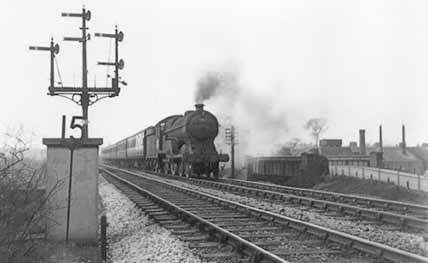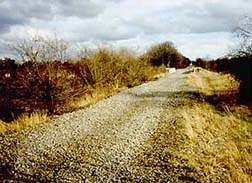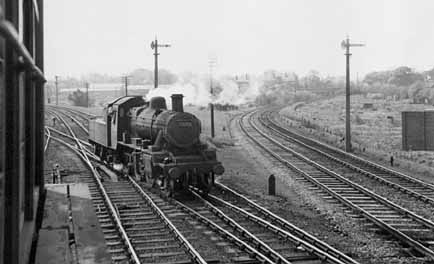A
Virtual
Stroll
Along
the
Mickle
Trafford-Shotton
Notes For a Controversial History, part I
 The
first
passenger
railway
service
in
the
world,
that
between
Liverpool
and
Manchester,
opened
in
September
1830,
and
the
railway
first
came
to
Chester
when
the
building
of
the
original
line
from
Warrington
to
Birmingham
in
1837
led
to
an
extension
of
the
line
to
Chester
in
1840. The
first
passenger
railway
service
in
the
world,
that
between
Liverpool
and
Manchester,
opened
in
September
1830,
and
the
railway
first
came
to
Chester
when
the
building
of
the
original
line
from
Warrington
to
Birmingham
in
1837
led
to
an
extension
of
the
line
to
Chester
in
1840. A line planned to run from Chester to Birkenhead never actually reached the Mersey, as there was a clause in the Act of Incorporation which stipulated that branch lines must be built to all the ferries, if to any at all, and this proved to be financially impossible. In 1846, a line opened between Chester and Ruabon in North Wales, and was soon extended to Holyhead, to meet the boats for Ireland, and this continues in service to this day. Around thirty years later, in 1875, the Manchester, Sheffield and Lincoln company constructed a new line running from Manchester via Altringham, Northwich and Delamere to the new Northgate Station in Chester. In 1890, the line was extended to Shotton, with new stations at Blacon and Saughall, and included a stretch which allowed trains from Manchester to bypass Northgate station. This in turn connected with others, allowing access to Hawarden and Wrexham, or to Bidston and from there to the popular resort of New Brighton, or to Birkenhead and on to Liverpool. Around this time, John Summers and Sons, steel manufacturers based at Stalybridge near Manchester, were looking for a second site, and the railway network favoured the eventual choice of Shotton, where they opened their new steelworks in September 1896. In addition to dealing with a large number of passengers, the line also carried a considerable amount of goods traffic- freight trains passing through Northgate station could carry anything from coal, steel, minerals and building materials through to agricultural produce- for example, milk churns from farms around Chester were transported to Manchester by rail. As part of the great reduction in the British railway network in the 1960s, the line was closed, and Northgate station demolished- the site is now occupied by the Northgate Arena sports centre and associated car park. Passenger trains from beyond Mickle Trafford were diverted there in order that they might use the General station on the other line. Goods continued to be carried on the 'bypass' line to Shotton.  In
1967,
Summers'
steelworks
passed
to
British
Steel,
but
in
1980,
the
works-
with
the
exeption
of
the
coating
plant-
closed
with
massive
job
losses. In
1967,
Summers'
steelworks
passed
to
British
Steel,
but
in
1980,
the
works-
with
the
exeption
of
the
coating
plant-
closed
with
massive
job
losses.For a while, the railway continued to be used for bringing in the massive steel rolls for coating, and for dispaching the finished work. With the continuing shrinking of the British steel industry, including the closure of the massive Ravenscraig works in Scotland, the remaining traffic was transferred to the roads and the Mickle Trafford to Shotton railway closed for good. Right: a dramatic photograph, kindly contributed by retired driver Ralph Hodgkinson, of the old railway back on the 23rd March 1957 (at 12.52 pm!) Locomotive 62669 roars over the bridge which crosses the Chester main line and the Brook Lane road bridge can be seen on the right hand side of the picture. The industrial area beyond- an aluminium processor and switchgear factory- is now the site of the Duke's Manor housing estate. • In 1984, a County Council report was produced on possible uses for the disused line. It discussed three options: a place to run preserved steam trains, tarmacking it over to form a new main road or converting it into a landscaped cycle path / bridleway and pedestrian footpath. The report pointed out the growing shortage of recreational green spaces in Chester- especially in Hoole and Blacon- and the economic and tourism advantages to the city of promoting cycling and strongly favoured acting upon the latter option- still the plan overwhelmingly favoured by the public to this day- which it stated could be undertaken at no great expense. However, despite warning that delay would lead to dereliction and problems for neighbouring homes, no action was taken and the line did indeed in places become a rubbish-strewn wasteland. • Eleven years later, in 1995, cycling charity Sustrans was awarded National Lottery money for the creation of a national cycle network, although Chester was excluded from this- the national route map was published showing gaps between the Welsh coastal route and Chester and also between Liverpool and Chester. •
Also
in
1995
came
the
first
public
exhibition
proposing
a guided
busway with
a
partial
cycleway
/
footpath
alongside.
From
the
start
it
was
greeted
by
the
public
with
rather
less
than
overwhelming
enthusiasm. • Opposition to their guided busway mounted as concerned individual members of the public failed to see the logic or merit of the scheme. •
Several
local
groups
and
individuals
tried
to
claim
credit
for
several
million
pounds
of
public
money
awarded
to
Chester
at
this
time.
This
award
failed
to
ensure
the
return
of Gyles
Brandreth as
Chester's
MP,
being
replaced
by
busway-friendly
former
Labour
councillor Christine
Russell. • The scheme gained all party- and, it was claimed- all council support (Chester City, Cheshire County and Flintshire County Councils)- and this despite the fact that the latter had not yet even been formed! This supposed 'support' by a non-existent entity must be extremely rare, if not unique, in local politics. Unimpressed by their betters, however, the citizens continued their opposition on environmental, safety, economic- and irrelevance- grounds. • Recruitment of a Busway 'supremo' was announced, one Carlton Roberts-James, a three year contract at a salary of £30,000-plus. •
Growing
local
opposition
was
articulated
at
the
Local
Plan
public
hearing
and
local
councillors
became
increasingly
paranoid
about
opposition
to
the
scheme,
a
number
of
them
writing letters to
the
local
press
containing
of
all manner of unsubstantiated
claims
and
assertions.
Their
efforts,
however,
continued
to
be
greatly
outnumbered
by letters
of
opposition from
exasperated
citizens.
Sections
of
the
local
press contributed
to
the
debate
by
'neglecting'
to
fully Chronicle the
views
of
those
many,
many
local
people
opposed
to
the
busway. • Still no indication of the sustainability of the proposed vehicles to be used on the route appeared. In fact, to date very few details about anything at all to do with the proposed vehicles- or who is to operate them- have ever been released to the public. •
Sustrans took
over
responsibility
for
constructing
a
footway
and
cycleway
and
submitted
a
planning
application.
Their
normal
practice
when
converting
old
railways
to
cycleways
is
to
construct
the
course
of
the
track
so
it
runs
over
varying
parts
of
the
old
track
bed
to
take
advantage
of
existing
trees
or
other
natural
features,
and
to
add
variety
to
the
route
and
interest
for
its
users.
Left: This fascinating photograph from May 1959, taken from the Chester East signal box. The right-hand branch is the modern course of the Sustrans Cycleway while the left-hand, which headed for the now-vanished Northgate Station, has gone without trace, to be replaced by a park and the housing estates of Northgate Village. (Thanks to Ralph Hodgkinson for this photograph) Much more about this major planning shambles may be learned by perusing our growing collection of letters to these pages and the Chester press in favour of the busway and- far, far more numerous!- letters against it. A true and accurate indication of public opinion! |
Site Front Door | Site Index | Railway History part II | III | Railway Stroll Introduction | CDTS Letters | Chester: A Virtual Stroll Around the Walls | Top of Page
 •
•  • In June
1998, Sustrans submitted
their
planning
appication
for
the
Chester
section
of
the
National
Cycle Network,
estimated
to
cost
around
£400,000.
A
city
council
spokesman
confirmed
that
the
application
dealt only with
the
cycleway,
and
that
"the
Busway
was
a
separate
issue,
for
which
funding
was
being
separately
sought"
• In June
1998, Sustrans submitted
their
planning
appication
for
the
Chester
section
of
the
National
Cycle Network,
estimated
to
cost
around
£400,000.
A
city
council
spokesman
confirmed
that
the
application
dealt only with
the
cycleway,
and
that
"the
Busway
was
a
separate
issue,
for
which
funding
was
being
separately
sought"